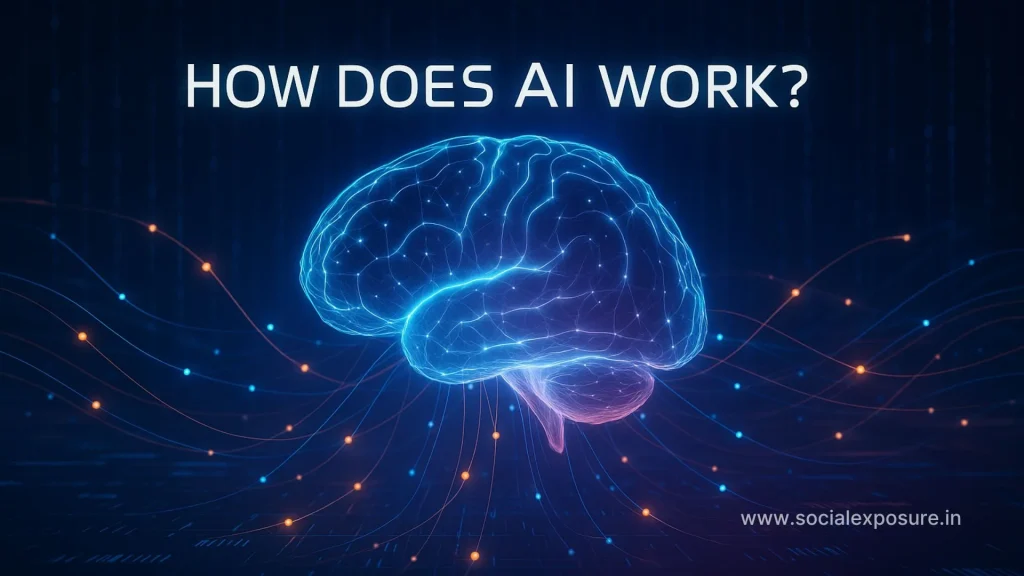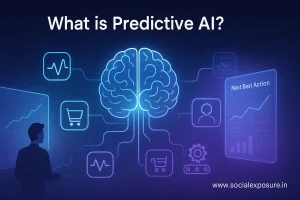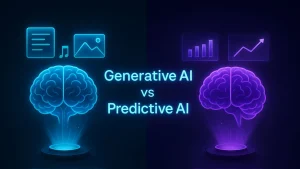If you’ve ever asked your phone a question, received a product suggestion while shopping online, or noticed how your photos get sorted automatically, you’re already interacting with AI. But what exactly makes this possible? And why is it more important than ever to understand artificial intelligence?
In simple terms, AI refers to systems designed to process information and perform tasks that normally require human thinking like recognizing patterns, making decisions, or learning from experience. It’s no longer just about futuristic robots. Today, artificial intelligence powers things behind the scenes in industries like healthcare, logistics, marketing, and customer support.
According to McKinsey’s 2023 global survey, 55 percent of organizations reported using AI in at least one business function, nearly doubling since 2017. What’s more, many businesses are now embedding generative AI into their daily workflows, showing just how quickly this field is expanding across sectors.
So, how does AI work at its core? And why should it matter to business owners, developers, students, and everyday users alike?
Let’s break it down in a way that’s easy to follow and useful starting from the basics and working our way into real-world use.
What Is AI and Why Does It Matter?
Picture this. You ask your voice assistant to set a reminder, get instant answers from a chatbot, or see personalized content on your social media feed. These are everyday examples of how AI works around you quietly, quickly, and constantly.
At its core, artificial intelligence is the ability of a machine or system to perform tasks that would normally require human intelligence. These tasks range from recognizing speech and images to making decisions based on patterns it has learned.
That’s where concepts like machine learning come into play. AI doesn’t just follow a fixed script; it learns and adapts from data. And when it understands human language and context, it’s often powered by natural language processing (NLP).
Today, AI is used in places many people don’t even realize. Search engines suggest what you might be looking for before you finish typing. E-commerce platforms show you products you’re likely to buy. Customer support bots answer questions at any hour, all while learning to improve with every interaction.
According to IBM’s 2024 Global AI Adoption Index, about 42 percent of large enterprise companies have already deployed artificial intelligence in their operations, with another 40 percent actively exploring its potential.This shows that AI has moved beyond theory and is now a fundamental part of modern business workflows, not just a future possibility.
So when we ask, how does artificial intelligence work, we’re not just talking about science fiction. We’re talking about the systems already shaping how we search, shop, work, and communicate.
How AI Works: A Step-by-Step Breakdown
For something that seems so advanced, the way AI works can actually be understood through a series of basic steps. Behind every smart assistant, recommendation engine, or self-learning chatbot is a system that follows a logical path: it takes in data, learns from it, and then acts on it. This section walks you through that process, without any overwhelming jargon.
What AI Needs to Function?
Everything starts with data. Whether it’s images, spoken words, or a stream of text messages, data is the fuel that powers every form of artificial intelligence. But AI doesn’t just store information it needs to process it using logic and structure. That’s where AI algorithms, models, and training come in.
There are two types of data at play:
- Structured data, like spreadsheets or labeled photos, is organized and easy for systems to sort.
- Unstructured data, like open-ended reviews or voice recordings, is more complex and requires extra layers of analysis.
To turn that data into something useful, AI models are built. These models are shaped by mathematical formulas and programming rules that help machines learn, adjust, and eventually make decisions. When combined, these elements form the core components of AI: input data, algorithmic logic, and models that adapt through experience.
How AI Learns from Data?
Once data is collected and organized, it needs to be used for training. That’s where machine learning comes in. This is the part where an AI system starts to recognize patterns and improve its predictions.
There are two common methods of training:
- Supervised learning: The AI is given labeled examples. For instance, hundreds of images marked as “cat” or “not a cat,” so the system learns what to look for.
- Unsupervised learning: The AI isn’t told what’s right or wrong. Instead, it finds patterns on its own, such as grouping similar customer behaviors or emails without knowing their categories in advance.
In both methods, the AI’s goal is to increase model accuracy and the ability to make the right call in future situations. This process of AI training is what allows systems to improve over time, even when faced with new information.
This is how artificial intelligence systems move from simply storing data to actually learning patterns and developing responses that can be trusted.
What Happens During the Inference Stage?
After training, AI doesn’t just sit idle. It moves into what’s called the inference stage. This is where it starts applying what it learned to make real-time decisions.
For example:
- A voice assistant hears a command and matches it to the most likely response
- An app suggests a product based on your past behavior
- A translation tool converts a sentence into another language with the right tone and context
All of this is happening during AI output the moment the system uses its training to create an action. Whether it’s flagging a suspicious transaction or recommending your next TV show, AI makes decisions quickly by comparing live input to what it has learned.
This is also where real-time AI processing becomes important, especially in fields like healthcare, cybersecurity, or navigation, where timing and precision matter.
Real-World Examples of AI in Action
To make all this easier to relate to, here are a few examples of how AI shows up in daily life and what’s happening behind the scenes:
- Voice assistants (like Alexa or Siri): Convert speech to text using NLP, analyze the command, and respond using pre-trained models.
- Email spam filters: Use supervised learning to recognize patterns common in spam messages and filter them accordingly.
- Product recommendations: Platforms like Amazon or Netflix study your behavior and compare it with millions of others to suggest what you might want next.
These are just a few ways AI helps us today often without us even realizing it. And the more data these systems are exposed to, the more accurate and personalized they become.
Understanding these real-world cases isn’t just about knowing the tech. It’s about seeing how the uses of AI are already shaping the tools we rely on, and why it’s worth understanding how artificial intelligence helps us beyond just headlines and hype.
Key Components That Make AI Work
Behind every smart application is a group of core technologies working together. While AI is often used as a broad term, it’s not a single tool. It’s a system built on different specialized fields that allow machines to think, learn, and respond.
Let’s explore the main components of AI that make this possible.
Machine Learning
Machine learning is what gives AI its learning ability. While AI is the umbrella term for machines that act intelligently, ML is a specific method that allows systems to improve through experience.
Here’s how it works:
- ML models are trained on data to find patterns
- These patterns are used to make predictions or decisions
- The more data a model processes, the more accurate it becomes
Unlike traditional programming, where every rule is written manually, AI and ML systems use learning algorithms to adjust themselves based on feedback. That’s why machine learning is not just useful, it’s essential for AI to grow smarter over time.
Neural Networks
Inspired by the human brain, neural networks in AI are designed to help machines process complex information. They’re built from layers of interconnected nodes, often referred to as neurons.
Each layer serves a purpose:
- The input layer receives data
- Hidden layers process that data through multiple transformations
- The output layer delivers the result
These networks are especially useful in tasks like image recognition or speech interpretation, where simple rules aren’t enough. As part of modern AI models, neural networks allow systems to handle information that’s far more nuanced than binary code.
Natural Language Processing
The reason chatbots can respond with relevant answers and search engines can understand your query is natural language processing. Commonly shortened to NLP, this field allows machines to understand, interpret, and generate human language.
NLP in AI works across various layers:
- Breaking down sentences into words and grammar structures
- Understanding context and tone
- Generating meaningful replies
You’ll see AI voice systems using NLP to turn spoken words into text, and then into actionable instructions. Whether you’re asking a question to a virtual assistant or getting a text response from a chatbot, NLP is doing the heavy lifting behind the scenes.
Computer Vision
When machines need to “see” the world, they rely on computer vision. This area of AI involves processing and interpreting images or video data in a way that lets the machine recognize objects, track movement, or even detect emotions.
Here are some real-world examples of how AI image processing is used:
- Security cameras use facial recognition to identify known individuals
- Self-driving cars detect lanes, signs, and obstacles
- Medical software analyzes scans to help detect early signs of illness
With visual recognition AI, systems move beyond just reading data—they observe and interact with the world visually.
These fields work together to bring artificial intelligence to life. While each one specializes in a different type of processing, they all connect to build smarter, faster, and more intuitive systems that support real-world applications across industries.
Is AI Just Machine Learning?
It’s a common question: is AI the same as machine learning? Not quite. Artificial intelligence is the broader concept. It includes any system or software that mimics human intelligence to perform tasks. Machine learning, on the other hand, is a specific method within that system used to teach machines how to learn from data.
So when people ask about the difference between AI and ML, think of it like this:
- AI is the full engine
- ML is one of the key parts that keeps it running
While AI and ML often work together, they are not interchangeable terms. Some AI systems use logic-based rules or natural language processing without learning from data. Others rely entirely on ML models to improve accuracy over time.
In short, AI includes ML, but goes further. It brings together many fields to build systems that don’t just learn they interpret, predict, and respond with context.
Conclusion
Understanding how does AI works isn’t just for engineers or tech companies anymore. It’s for anyone curious about how the tools around us think, learn, and respond.
From voice assistants to personalized shopping experiences, the systems behind these features are built on layers of artificial intelligence that gather data, recognize patterns, and respond in ways that feel intuitive. Knowing what powers them gives you more control over how you interact with technology and how it might shape your work, learning, or daily life.
If you’ve ever wondered how AI helps us beyond just convenience, the answer lies in its growing role across industries. And this is just the beginning. As AI continues to evolve, the best thing you can do is stay informed.
If you want to understand more advanced AI topics, keep an eye on our blog. We’ll continue breaking down complex ideas in simple, practical ways.
Brought to you by Social Exposure, known as the Best Digital Marketing Agency dedicated to making technology easier to understand and apply.
Frequently Asked Questions
What is the main goal of AI?
The main goal of AI is to build systems that can perform tasks requiring human-like intelligence, such as learning, understanding, and decision-making. These systems help solve problems faster and more efficiently across different industries.
How does artificial intelligence learn?
Artificial intelligence learns by processing large amounts of data through models trained to find patterns. It uses methods like supervised and unsupervised learning to improve accuracy and make better predictions over time.
What are the main components of AI?
The core components of AI include data, algorithms, models, machine learning, natural language processing, neural networks, and computer vision. These work together to help AI systems process information and take action.
Can AI make decisions on its own?
Yes, AI can make decisions based on the data it has been trained on. However, the quality of its decisions depends on how well the model is built, the accuracy of the data, and the specific task it’s designed to handle.
Is AI dangerous or safe?
Artificial intelligence is safe when used responsibly, but risks can arise if it’s poorly trained or misused. The key to safety is building transparent systems with proper data handling, monitoring, and clear human oversight.
What are neural networks in AI?
Neural networks in AI are systems designed to process information in layers, much like how the human brain works. They’re made up of nodes that connect and help machines recognize patterns in data, such as faces in images or keywords in text.
How does AI process language?
AI processes language using a method called natural language processing. It breaks down sentences, understands context, and generates relevant responses. This is how tools like chatbots and voice assistants work in real time.
How does AI help businesses grow?
AI helps businesses grow by improving efficiency, automating routine tasks, enhancing customer service, and offering better insights through data analysis. These improvements often lead to reduced costs and smarter decision-making.






